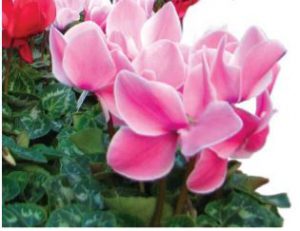Green Fingers: Cyclamen
 As you enter our garden centre you will see amongst the family photographs one very old photograph of my father (probably taken in the 1950’s), standing proudly in his greenhouse among his crop of Cyclamen that are in full bloom. In those days it was a crop that would have taken 18 months to produce from seed, now with modern breeding and growing techniques we can grow better plants in less than half the time.
As you enter our garden centre you will see amongst the family photographs one very old photograph of my father (probably taken in the 1950’s), standing proudly in his greenhouse among his crop of Cyclamen that are in full bloom. In those days it was a crop that would have taken 18 months to produce from seed, now with modern breeding and growing techniques we can grow better plants in less than half the time.
In those days with very few centrally heated homes father’s cyclamen would thrive for many months. Today to enjoy these beautiful plants for a long time we must remember that they need lower temperatures than we live in today.
As with most plants it is worth knowing what their origins are and what conditions they thrive on in the wild. They originated from the Middle East, particularly the alpine slopes of Turkey, where they are found in abundance in cool moist areas. They first became popular as a house and conservatory plant in late Victorian times, growing exceptionally well in the cool, damp pre-centrally heated homes of that period.
Today we have many hybrids and varieties including the relatively new miniature varieties, growing to six inches or less, many with scented flowers. Here are a few things to look for – try to buy your cyclamen plant in the late autumn, October, November and early December. Look under the leaves and choose one with lots of unopened buds as well as open flowers. Beware of those offered for sale in a paper cellophane sleeve and in a shop with high temperatures.
Remember, cyclamen like to be cool, 50 – 60oF is the ideal temperature. Place in bright winter light away from direct sun, such as a north facing windowsill, but avoid those with a radiator underneath. Stand on a tray or in a large pot cover with a few pebbles in the bottom and keep the pebbles moist to increase the humidity surrounding the plant. When the plant begins to droop slightly, stand it in a saucer of water adding a drop of liquid feed for about half an hour and then return to its pebble tray. Try to keep the crown of the plant dry.
When the flowers fade remove them by twisting the stems slightly and giving a sharp tug. The stem should come away from the corm cleanly. The same applies to any leaves that may need removing – if left the stems will rot and destroy the buds developing in the crown.
The most common cause of early plant death is high temperatures and dry air. This causes yellow leaves that are small with long stalks, so check the temperature. Anything over 60oF, for long periods of time, will drastically shorten its life. Other possible causes of the above symptoms are lack of water or direct sunlight.
I had one customer and friend, now sadly no longer with us who for many years bought six cyclamen plants from me just as the first flowers appeared at the end of October. He placed three in his cold porch and the other three in their centrally heated home, alternating them twice a week. In this way they were able to keep them well into May sometimes June.
A TIP FROM BRIAN
Probably the most difficult spot in the garden to grow plants is under mature trees where the soil is packed with roots. There is very little depth of soil and it is low in moisture and nutrients.
Ideally suited for these conditions is the alpine cyclamen hederifolium. These will set seed and in time, if undisturbed, form a carpet of glossy, marbled leaves and produce masses of dainty flowers in the autumn. Mix them with the spring flowering Cyclamen coum for another flush of flowers in the spring.
Written by Mr. Brian Wheat
Managing Director of Wm Wheat & Son Ltd. Flower & Garden Centre
520 Chester Rd, Little Aston, Aldridge, Walsall
0121 353 409




